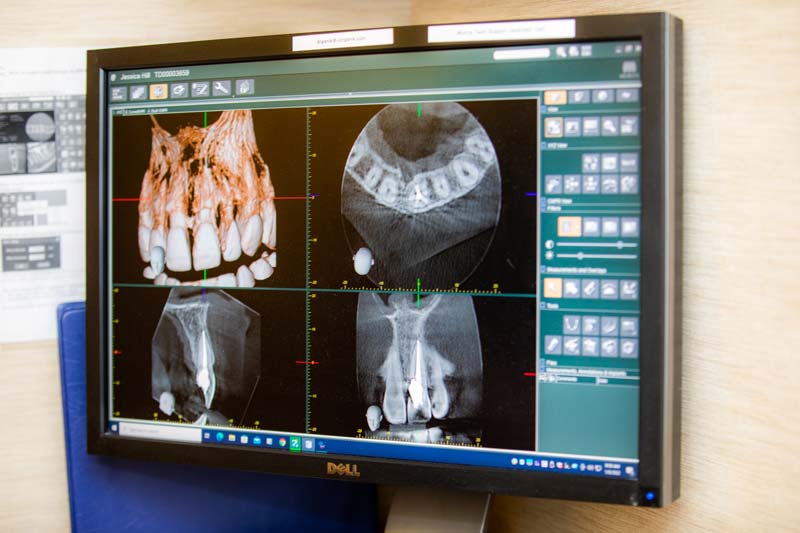

Dental emergencies are a common problem affecting people of all ages, but the majority of traumatic dental injuries impact children and teenagers. In 2020, more than 47,115 people visited U.S. hospital emergency rooms for injuries impacting their teeth. An estimated 31,749 of these injuries were in children aged 18 and younger, and of those, roughly 17,600 injuries were associated with sports and recreational activities. Dental trauma can result in fractures to the alveolar bone (which holds teeth in place), displaced or knocked-out teeth, pulp and root injuries, and dental abscesses. At Advanced Endodontics of New York, we have the right skills and experience to accurately diagnose and treat a comprehensive range of non-life-threatening endodontic dental emergencies in our office. If you or a family member suffers an endodontic emergency in New York, NY, you can count on us to provide timely and compassionate treatment.
In 2020, more than 47,115 people visited U.S. hospital emergency rooms for injuries impacting their teeth.


The combination of two different types of concurrent injuries to the same tooth is more detrimental than a single injury. For example, concurrent crown fractures with another type of tooth injury (for example, a lateral luxation, which is when the alveolar bone that holds your teeth in place fractures and the periodontal ligament separates) significantly increases the risk of pulp death and infection in mature permanent teeth.
A dental abscess is often caused by inflamed and infected dental pulp that is left untreated. The primary symptoms include a toothache, pain when chewing, tooth sensitivity to hot and/or cold, and swollen gums. Our endodontists specialize in treating dental abscesses with root canal treatment or endodontic surgery using surgical microscopes and the GentleWave treatment. This advanced technology combines fluid dynamics with a broad range of soundwaves to reach into microscopic spaces and remove bacteria, debris and tissue. After we clean and remove inflamed or infected pulp, the root canal is shaped and filled, then the space is sealed. A crown or other restoration is required to protect the tooth and fully restore its function.
Pulpitis is painful inflammation of the dental pulp, caused by untreated decay, trauma or multiple restorations. In primary teeth with reversible pulpitis and vital pulp, treatment includes a protective liner, indirect pulp treatment, direct pulp capping, or a pulpotomy. In permanent mature teeth, the tooth can usually be saved with a simple filling.
In primary teeth with irreversible pulpitis or dead pulp, nonvital pulp treatment includes pulpectomy and lesion stabilization/tissue repair. The American Association of Endodontists states that mature permanent teeth clinically diagnosed with irreversible pulpitis should be treated with a pulpectomy and root canal filling, because inflamed vital pulp doesn’t have the capacity to heal.
Tooth enamel can withstand a lot of wear and tear, but clenching or chewing on hard food can lead to a cracked tooth. Other causes include loss of tooth structure due to large fillings, root-canal-treated teeth that have not been restored with crowns, and dental trauma. Symptoms include pain when chewing or biting, especially when you release the bite; sensitivity to heat, cold or sugary food and drinks; intermittent pain that is rarely continuous; and swollen gums around the affected tooth. If you experience these symptoms and think you have a cracked tooth, it’s important to seek treatment quickly before the problem gets worse and the risk of losing your tooth increases. Cracks that extend into the pulp can be treated with a root canal procedure followed by a crown, while cracks that extend below the gum line require extraction. Chips in molars can be repaired with composite fillings, while bonding or porcelain veneers are typically used to fix chips in front teeth.
As mentioned above, a lateral luxation is characterized by fracture to the alveolar bone and separation of the periodontal ligament. The result is a dislodged tooth that is partially pushed into or out of its socket. While the tooth isn’t loose, it sits forward, backward or sideways in the gum line. If this happens to you, contact us as soon as possible. Diagnosis is based on your dental history, clinical examination and radiographic findings. In acute lateral luxation, there is a lack of pulpal response, including no response to sensibility tests. In adults, we typically recommend a root canal a few days after this type of injury. Children aged 7–12 typically don’t need root canal treatment because their teeth are still developing, however, we’ll monitor their healing carefully and intervene immediately if unfavorable changes occur.
If your tooth was knocked out in an accident or fell out after it became loose, pick it up by the crown, being careful not to touch the root. Then rinse it quickly in water and put it in a cup of milk. Putting it in water causes the cells of the tooth root to swell up and burst, while milk doesn’t cause this reaction. Milk has proteins that maintain a perfect pH balance and antibacterial substances and sugars that promote cell growth. Taking this simple step increases the possibility that we can replant the tooth in your mouth, ideally within an hour of losing the tooth. If this type of endodontic emergency in New York, NY happens during office hours, don’t worry about making an appointment and come to our practice immediately. Treatment includes splinting the replanted tooth to the surrounding teeth for seven to 10 days. If the bone around your tooth is also fractured, we’ll leave the splint in place for at least six weeks. We’ll also evaluate your dental pulp and if necessary, schedule a root canal within two weeks.

Making you comfortable and helping you heal are always our top priorities.
If you have any type of dental or endodontic emergency in New York, NY, we offer same- or next-day appointments. We’ll accurately diagnose the underlying cause of the problem, relieve your discomfort, and always do our very best to save your tooth and fully restore its function. We offer several types of sedation to alleviate dental anxiety and ensure your ultimate comfort. There is no need to worry about affording unplanned emergency dental care because we accept many insurance plans and we’ll work hard to maximize your benefits. We also partner with a leading third-party financing company to help you pay for unexpected emergency dental care.
I understand the information disclosed in this form may be subject to re-disclosure and may no longer be protected by HIPAA privacy regulations and the HITECH Act.
